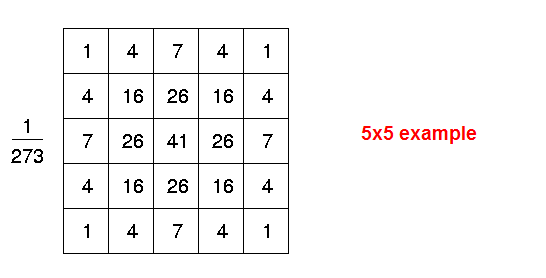高斯平滑 高斯模糊 高斯濾波器 ( Gaussian Smoothing, Gaussian Blur, Gaussian Filter ) C++ 實現
在之前提到過了均值濾波器, 就是說某像素的顏色, 由以其為中
那麼這些權重如何分布呢? 我們先來看幾個經典的模板例子(權重


嘗試了使用這些濾波器對我們原來的圖進行操作, 得到了這樣的一

原圖:

3x3 高斯:

5x5 高斯:
單純從效果來看, 兩個模板都起到了平滑的作用, 只是程度有深

這就是1維的計算公式

這就是2維的計算公式
x, y表示的就是當前點到對應點的距離, 而那些具體的模板就是由這
Sample Gaussian matrix
This is a sample matrix, produced by sampling the Gaussian filter kernel (with σ = 0.84089642) at the midpoints of each pixel and then normalising. Note that the center element (at [4, 4]) has the largest value, decreasing symmetrically as distance from the center increases.
0.00000067 0.00002292 0.00019117 0.00038771 0.00019117 0.00002292 0.00000067
0.00002292 0.00078633 0.00655965 0.01330373 0.00655965 0.00078633 0.00002292
0.00019117 0.00655965 0.05472157 0.11098164 0.05472157 0.00655965 0.00019117
0.00038771 0.01330373 0.11098164 0.22508352 0.11098164 0.01330373 0.00038771
0.00019117 0.00655965 0.05472157 0.11098164 0.05472157 0.00655965 0.00019117
0.00002292 0.00078633 0.00655965 0.01330373 0.00655965 0.00078633 0.00002292
0.00000067 0.00002292 0.00019117 0.00038771 0.00019117 0.00002292 0.00000067
是不是看到就頭大了:) 不過沒關系, 對於一般的應用來說,
view plaincopy to clipboardprint?
/**
** method to remove noise from the corrupted image by gaussian filter value
* @param corrupted input grayscale binary array with corrupted info
* @param smooth output data for smooth result, the memory need to be allocated outside of the function
* @param width width of the input grayscale image
* @param height height of the input grayscale image
*/
void gaussianFilter2 (unsigned char* corrupted, unsigned char* smooth, int width, int height)
{
int templates[25] = { 1, 4, 7, 4, 1,
4, 16, 26, 16, 4,
7, 26, 41, 26, 7,
4, 16, 26, 16, 4,
1, 4, 7, 4, 1 };
memcpy ( smooth, corrupted, width*height*sizeof(unsigned char) );
for (int j=2;j<height-2;j++)
{
for (int i=2;i<width-2;i++)
{
int sum = 0;
int index = 0;
for ( int m=j-2; m<j+3; m++)
{
for (int n=i-2; n<i+3; n++)
{
sum += corrupted [ m*width + n] * templates[index++] ;
}
}
sum /= 273;
if (sum > 255)
sum = 255;
smooth [ j*width+i ] = sum;
}
}
}
附帶說一些,很明顯,和均值濾波器類似, 這個濾波器沒有消除校
本文來自CSDN博客,轉載請標明出處:http://








 本文介绍了高斯平滑(Gaussian Smoothing)、高斯模糊(Gaussian Blur)和平滑滤波器的概念,并通过C++代码展示了5x5高斯模板的应用。高斯滤波器通过加权平均降低了像素与其周围像素的差异,其中权重遵循高斯分布。提供的代码示例用于从噪声图像中去除噪声。
本文介绍了高斯平滑(Gaussian Smoothing)、高斯模糊(Gaussian Blur)和平滑滤波器的概念,并通过C++代码展示了5x5高斯模板的应用。高斯滤波器通过加权平均降低了像素与其周围像素的差异,其中权重遵循高斯分布。提供的代码示例用于从噪声图像中去除噪声。














 355
355

 被折叠的 条评论
为什么被折叠?
被折叠的 条评论
为什么被折叠?








